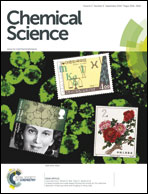Graphene nucleation on a surface-molten copper catalyst: quantum chemical molecular dynamics simulations†
Abstract
Chemical vapor deposition (CVD) growth of graphene on Cu(111) has been modeled with quantum chemical molecular dynamics (QM/MD) simulations. These simulations demonstrate at the atomic level how graphene forms on copper surfaces. In contrast to other popular catalysts, such as nickel and iron, copper is in a surface molten state throughout graphene growth at CVD-relevant temperatures, and graphene growth takes place without subsurface diffusion of carbon. Surface Cu atoms have remarkably high mobilities on the Cu(111) surface, both before and after graphene nucleation. This surface mobility drives “defect healing” processes in the nucleating graphene structure that convert defects such as pentagons and heptagons into carbon hexagons. Consequently, the graphene defects that become “kinetically trapped” using other catalysts, such as Ni and Fe, are less commonly observed in the case of Cu. We propose this mechanism to be the basis of copper's ability to form high-quality, large-domain graphene flakes.


 Please wait while we load your content...
Please wait while we load your content...